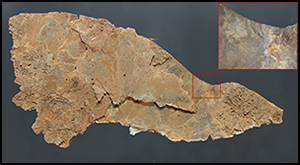Crossref Citations
This article has been cited by the following publications. This list is generated based on data provided by
Crossref.
2015.
Current Bibliography of the History of Science and Its Cultural Influences, 2015.
Isis,
Vol. 106,
Issue. S1,
p.
i.
Wright, Alice P.
2015.
Private property, public archaeology: resident communities as stakeholders in American archaeology.
World Archaeology,
Vol. 47,
Issue. 2,
p.
212.
Miller, G. Logan
2015.
Ritual economy and craft production in small-scale societies: Evidence from microwear analysis of Hopewell bladelets.
Journal of Anthropological Archaeology,
Vol. 39,
Issue. ,
p.
124.
Henry, Edward R.
and
Barrier, Casey R.
2016.
The organization of dissonance in Adena-Hopewell societies of eastern North America.
World Archaeology,
Vol. 48,
Issue. 1,
p.
87.
Henry, Edward R.
2017.
Building Bundles, Building Memories: Processes of Remembering in Adena-Hopewell Societies of Eastern North America.
Journal of Archaeological Method and Theory,
Vol. 24,
Issue. 1,
p.
188.
Thompson, Victor D.
Pluckhahn, Thomas J.
Colvin, Matthew H.
Cramb, Justin
Napora, Katharine G.
Lulewicz, Jacob
and
Ritchison, Brandon T.
2017.
Plummets, public ceremonies, and interaction networks during the Woodland period in Florida.
Journal of Anthropological Archaeology,
Vol. 48,
Issue. ,
p.
193.
Wright, Alice P.
2017.
Local and “Global” Perspectives on the Middle Woodland Southeast.
Journal of Archaeological Research,
Vol. 25,
Issue. 1,
p.
37.
Mueller, Natalie G.
2018.
The earliest occurrence of a newly described domesticate in Eastern North America: Adena/Hopewell communities and agricultural innovation.
Journal of Anthropological Archaeology,
Vol. 49,
Issue. ,
p.
39.
Henry, Edward R.
Shields, Carl R.
and
Kidder, Tristram R.
2019.
Mapping the Adena-Hopewell Landscape in the Middle Ohio Valley, USA: Multi-Scalar Approaches to LiDAR-Derived Imagery from Central Kentucky.
Journal of Archaeological Method and Theory,
Vol. 26,
Issue. 4,
p.
1513.
Henry, Edward R.
Mickelson, Andrew M.
and
Mickelson, Michael E.
2020.
Documenting Ceremonial Situations and Institutional Change at Middle Woodland Geometric Enclosures in Central Kentucky.
Midcontinental Journal of Archaeology,
Vol. 45,
Issue. 3,
p.
203.
Henry, Edward R.
Mickelson, Andrew M.
and
Mickelson, Michael E.
2020.
Documenting Ceremonial Situations and Institutional Change at Middle Woodland Geometric Enclosures in Central Kentucky.
Midcontinental Journal of Archaeology,
Vol. 45,
Issue. 3,
p.
203.
Everhart, Timothy D.
and
Ruby, Bret J.
2020.
Ritual Economy and the Organization of Scioto Hopewell Craft Production: Insights from the Outskirts of the Mound City Group.
American Antiquity,
Vol. 85,
Issue. 2,
p.
279.
Henry, Edward R.
Wright, Alice P.
Sherwood, Sarah C.
Carmody, Stephen B.
Barrier, Casey R.
and
Van de Ven, Christopher
2020.
Beyond Never-Never Land: Integrating LiDAR and Geophysical Surveys at the Johnston Site, Pinson Mounds State Archaeological Park, Tennessee, USA.
Remote Sensing,
Vol. 12,
Issue. 15,
p.
2364.
Wright, Alice P.
and
Gokee, Cameron
2021.
Composing Complexity in the Eastern Woodlands.
Current Anthropology,
Vol. 62,
Issue. 1,
p.
30.
Holland-Lulewicz, Jacob
2021.
From Categories to Connections in the Archaeology of Eastern North America.
Journal of Archaeological Research,
Vol. 29,
Issue. 4,
p.
537.
Henry, Edward R.
Mueller, Natalie G.
and
Jones, Mica B.
2021.
Ritual dispositions, enclosures, and the passing of time: A biographical perspective on the Winchester Farm earthwork in Central Kentucky, USA.
Journal of Anthropological Archaeology,
Vol. 62,
Issue. ,
p.
101294.
Menz, Martin
2022.
Domestic Architecture at Letchworth (8JE337) and Other Woodland Period Ceremonial Centers in the Gulf Coastal Plain.
American Antiquity,
Vol. 87,
Issue. 2,
p.
389.
Quinn, Colin P.
Walker, Emily
and
Wright, Alice
2022.
Late Woodland settlement ecology of the Appalachian Summit.
Southeastern Archaeology,
Vol. 41,
Issue. 1,
p.
32.
Sanger, Matthew C.
2022.
Anarchy, institutional flexibility, and containment of authority at Poverty Point (USA).
World Archaeology,
Vol. 54,
Issue. 4,
p.
555.
Thompson, Victor D.
2023.
Considering Ideas of Collective Action, Institutions, and “Hunter-Gatherers” in the American Southeast.
Journal of Archaeological Research,
Vol. 31,
Issue. 4,
p.
503.



